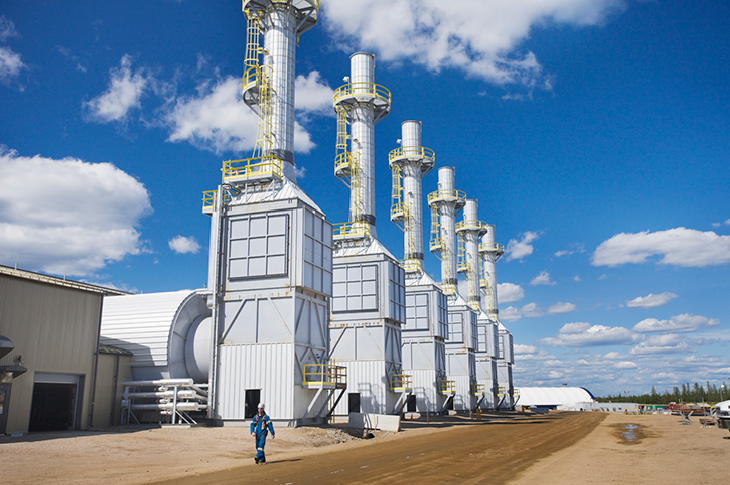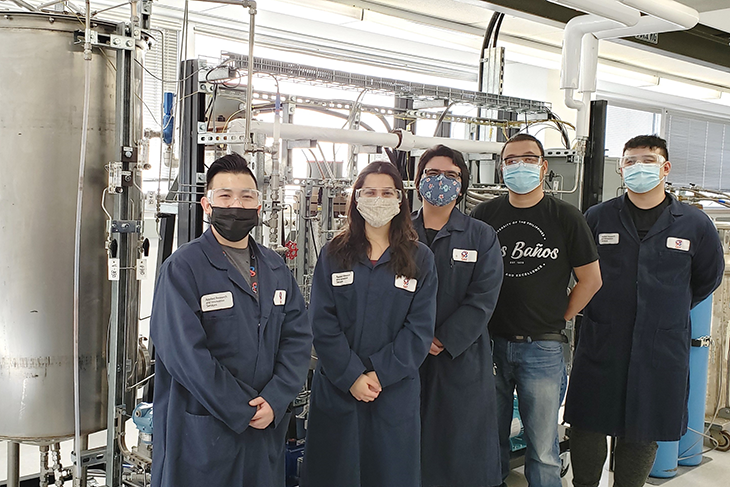In-situ steam research contributes energy and environmental solutions in oilsands operations

A $2-million research collaboration between the University of Calgary, University of Alberta and Southern Alberta Institute of Technology (SAIT) is focused on finding improved energy and environmental solutions to one of the oilsands industry’s most common operational problems: erosion and corrosion in once-through steam generators (OTSG).
As part of the project, researchers from SAIT have opened a second, new OTSG laboratory at the University of Calgary Research Centre building in University Research Park. The new lab will use scaled-model OTSG pilot rigs to conduct in-situ steam research, allowing testing to take place without having to compromise commercial units in the field.
“OTSG#3 is the first of two erosion-corrosion pilot rigs in the new lab, which is overseen by SAIT’s Centre for Energy Research in Clean Unconventional Technology Solutions (CERCUTS) within in the department of Applied Research and Innovation Services (ARIS),” says Tom Bornhorst, Vice President Corporate Development, Applied Research and International at SAIT.
“This research will not only engage industry mentors, researchers, faculty and staff, but also enhance experiential learning. Students will develop scientific and innovative clean-technology solutions, test their ideas in the lab and potentially contribute to novel, practical and sustainable ways of resolving relevant technical and environmental issues.”
Supported by funding from the Natural Sciences and Engineering Research Council of Canada (NSERC) and Canada’s Oil Sands Innovation Alliance (COSIA), the five-year research collaboration is led by Dr. Bernhard Mayer, principal investigator, University of Calgary, with co-principal investigators, Dr. Vita Martez from SAIT and Dr. Sean Sanders from the University of Alberta.
“This research will provide insights into fouling and erosion/corrosion fundamentals previously unavailable to operators, even after more than 30 years of commercial operation,” says John Brogly, director of COSIA’s water and tailings environmental priority areas.
“The research insights, which will include better mitigation measures for these problems, will result in more efficient operation of commercial once-through steam generators, reducing the environmental footprint as well as costs for the oilsands in situ sector,” Brogly says.
OTSGs used in recovery of bitumen
Widely used in steam-assisted gravity drainage (SAGD) oilsands operations, OTSGs are a type of boiler that produces steam for the recovery of bitumen and produced water. Produced water is then treated to make boiler feed water.
“An OTSG is a drum-less boiler that typically generates superheated steam efficiently from boiler feed water in a vertically or horizontally configured bundle of tubes in a single pass,” says Martez, NSERC Industrial Research Chair for Colleges in Oil Sands In-Situ Steam Generation and Clean Technologies at SAIT.
OTSGs recycle oilsands produced water for steam production allowing for improved energy efficiency, while also reducing greenhouse gas emissions.
The produced water typically contains considerable amounts of dissolved constituents including calcium, magnesium, iron, sodium, silica, organics and suspended matter, such as bitumen.
Some of the dissolved inorganic and organic constituents propagate into the boiler feed water. When steam is generated, the presence of these constituents in the water causes fouling or the accumulation of organic/inorganic deposits in the OTSGs. Over time, this can lead to corrosion and erosion, which can then cause premature and costly OTSG failures.

Pilot rigs are a unique aspect of research collaboration
The OTSG#3 is a scaled down model of a commercial OTSG, specifically built for the research collaboration. It will be used to generate similar steam conditions as seen in normal in-situ operations to mimic corrosion/erosion tendencies. The outcome will result in process improvements and achieve practical solutions tailored to addressing erosion/corrosion.
Led by Martez, a team of multi-disciplinary researchers from SAIT will investigate, operate, test, troubleshoot and maintain the pilot rigs for the project at the new OTSG#3 lab.
“The OTSG#3 pilot rig will be used to intake boiler feed water with total dissolved solids of up to 12,000 parts per million in order to investigate and evaluate the erosion and corrosion on a test article that is situated downstream of the steam generator,” says Martez.
“This specialized equipment will allow students and researchers from three academic institutions to find solutions by conducting various investigations and experiments, using both synthetic water and typical boiler feed water from SAGD facilities.”
OTSG#3 was built in Alberta with intellectual property transferred from Suncor Energy, and inputs from scientists of the former General Electric Water and Process Technologies, New York.
“The opportunity for SAIT’s CERCUTS team to be part of COSIA’s focused plan collaborating with two universities in finding scientific solutions to energy efficiency and emission reduction is very exciting and timely right now,” says Joseph Apawan, OTSG#3 lab coordinator.
“The results of the in-situ steam research aim to determine the factors that contribute to significant environmental benefits in water management, energy efficiency and emissions reduction,” says Dr. Aprami Jaggi, a research scientist overseeing the OTSG#3 research.
This OTSG steam generation research at SAIT is supported by the Natural Sciences and Engineering Research Council of Canada (NSERC), Canada Foundation for Innovation (CFI), the Government of Alberta’s Research Capacity Building Program, Alberta Innovates-Environmental Innovation, Canada’s Oil Sands Innovation Alliance (COSIA), Suncor Energy Inc., Canada First Research Excellence Fund, Spartan Controls, and other valued industry and funding partners.
Industry Driven
We prepare students for successful careers and lives.
SAIT'S
2020-2025
Strategic plan